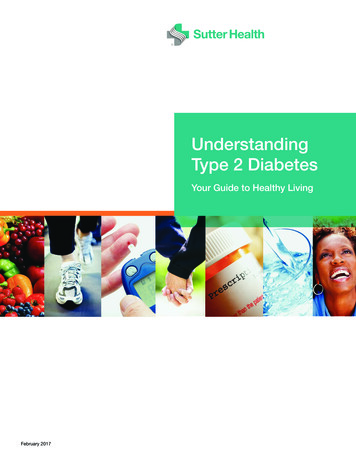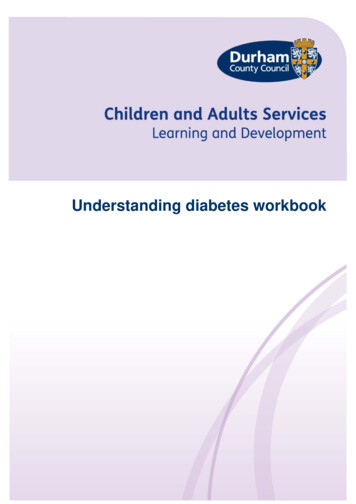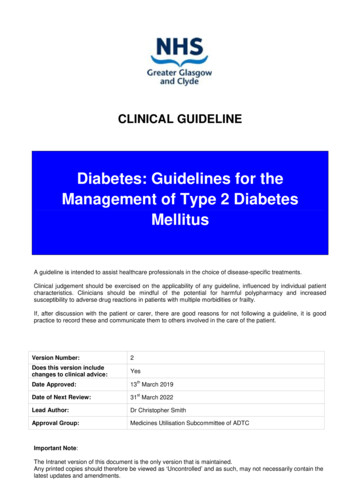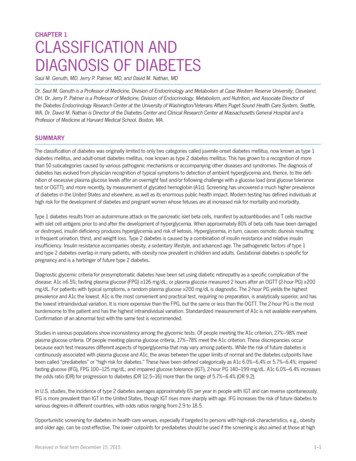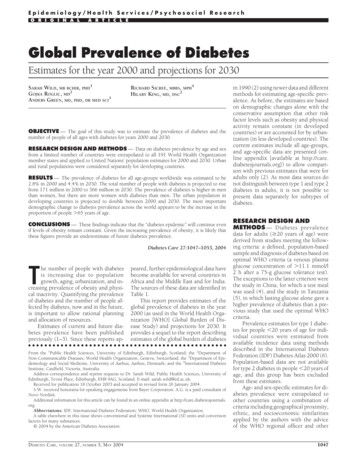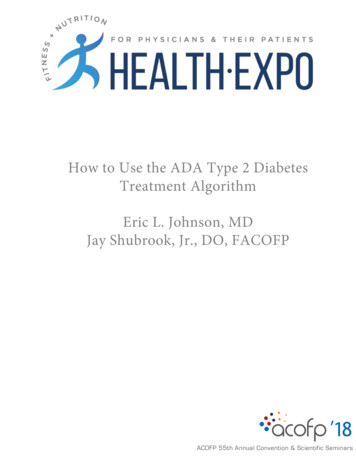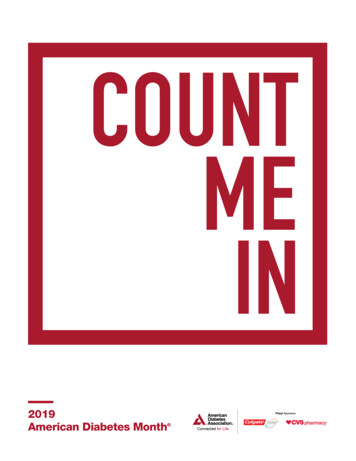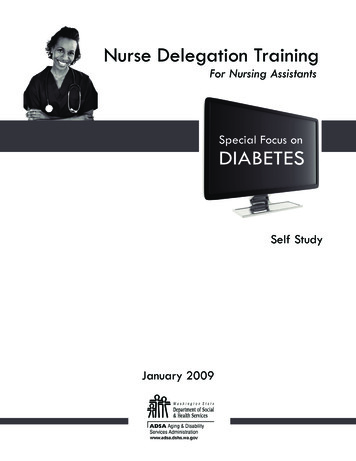
Transcription
A Guide to UnderstandingDiabetes Self Management
ContentsWhat is Diabetes?.3Type 1Type 2Gestational DiabetesHealthy Eating.4Plate MethodCarbohydrate CountingReading a LabelBeing Active.6Types of ExerciseBenefits of ExerciseMonitoring.7Blood SugarA1cProblem Solving.8HypoglycemiaHyperglycemiaSick Day CareTaking Medicine.11Types of Medicine – Pills and Injectable MedicinesMedicine TipsReducing Risks. 12Complications of DiabetesHealthy Coping. 13Emotional HealthStressDepressionBlood Sugar Log. 15Diabetes Management Pocket Card. 172
What is Diabetes?Diabetes is a disease in which the sugar level in yourblood is high. It’s a lifelong condition. When you eatfood that contains carbohydrates, the food is brokendown into a simple sugar called glucose. This sugartravels in your blood to all cells in your body and is usedfor energy. Insulin (a hormone made by the pancreas) isreleased into the bloodstream and allows the sugars toenter your cells. Without insulin, sugar remains in theblood, causing complications or damage.Second, over time, your body’s ability to make insulindecreases and you may not make enough insulin tomeet your needs. This is called insulin deficiency. Mostpeople with diabetes have type 2. Anyone may developdiabetes but there are some factors that increase yourrisk for developing type 2: There are three common types of diabetes:type 1, type 2 and gestational diabetes.Type 1 DiabetesWith type 1 diabetes, your body makes little or noinsulin. It’s not always clear what causes type 1diabetes, but researchers believe autoimmunity,genetics and possibly viruses play a role. People withtype 1 diabetes must take insulin every day. Type 1diabetes usually happens in children or young adults,but it may appear at any age.Family history of diabetesLack of physical activityBeing overweightBeing over the age of 45History of gestational diabetes Being African American, Native American, Latino,Asian American, Asian, Indian or Pacific IslanderTwo things you can do to decrease insulin resistanceand allow the body to use insulin better are eatinghealthy and increasing physical activity. These topicswill be discussed later in this booklet.Gestational DiabetesGestational diabetes results from high blood sugar thatdevelops during pregnancy. Blood sugar levels usuallyreturn to normal after the baby is born. However, havinggestational diabetes increases the risk of developingtype 2 diabetes later in life.Type 2 DiabetesWith type 2 diabetes, there are two main causes ofhigh blood sugar. First, your body doesn’t effectivelyuse the insulin it makes. This is called insulin resistance.3
Healthy EatingA key approach to controlling blood sugar (glucose) iseating healthy foods every day. It isn’t necessary to stopeating all the foods you like. But it’s important to knowwhat you’re eating and how those foods affect yourblood sugar.1. Plate MethodThis method allows you tolearn portion control andhow to make a nutritionallywell-rounded plate. Start byusing a nine-inch plate.Often, when people are told they have diabetes, theydon’t know where to begin. The first step is making ameal plan. Those who have had diabetes for a whilemay also feel frustrated or limited in their meal choices.¼ plate protein3-4 oz. cooked skinless chicken or turkey, fish, seafood,lean beef, lean pork, tofu, eggs, cheeseThere are three common approaches to meal planningthat may help you manage your blood sugar levels.Work with your health care team to choose the methodthat works best for you.¼ plate carbohydrateStarchy vegetable or whole grain food such as bread, pasta,rice, cereals, beans, corn, potatoes, crackers, pretzels½ plate non starchy vegetables:Carrots, green beans, lettuce, broccoli, greens, cabbage,cauliflower, tomatoes, Brussels sprouts, kale, onions,cucumber, beets, okra, mushrooms, peppers, turnips,radishes, spinach, bok choy, asparagus, artichoke hearts,eggplant, leeks, mushrooms, squash, sugar snap peas,water chestnuts1. Plate method2. Counting carbohydrate servings3. Counting grams of carbohydratesWhat are carbohydrates? Carbohydrates raise blood sugar levels higher andfaster than other foods. Carbohydrates are a major energy source. Carbohydrates turn into sugar in the blood. Thissugar then works with your own or your injectedinsulin to make energy.2. Carbohydrate ServingsCounting your servings of carbohydrate is anotherway to create your diabetes meal plan. Be aware thatstarches, sugar and fiber all contain carbohydrate.It is also important to note the serving size of eachcarbohydrate you are eating.Examples of carbohydrate sources are: Grains - bread, cereal, rice, pasta, crackers, chips Starchy vegetables - potatoes, corn, beans, peas,winter squash Fruit and fruit juice - apples, berries, melons,oranges, grapes, bananas Milk - cow’s milk, buttermilk, yogurt Sweets - cookies, candy, cakes, soda3. Counting Carbohydrate Grams15 Grams of Carbohydrates One ServingBy controlling the amount of carbohydrates you eat, youwill help keep your blood sugar within your target range.Carb ServingsPer MealGrams of CarbsPer MealWomen3-445-60gMen4-560-75gSnacks115gThis chart lists basic guidelines. However, a dietitiancan help you figure out the number of carbohydrateservings or grams that’s right for you.Sweets and desserts are carbohydratechoices that don’t offer the nutritionother carbohydrate sources may offer,and you should limit your portion sizes.It’s important to eat about the same amount ofcarbohydrates at each meal. This helps the body usethe sugar more efficiently and maintain steady bloodsugar. Eating meals evenly spaced throughout the dayis important to stay in your target range. Don’t eat mostof your food at one time.4
Reading a Nutrition Facts LabelIf you’re unsure about how much carbohydrate a foodhas, refer to the product’s nutrition label.Start with servingsize. This will tell youhow much food is inone serving. If youeat more than oneserving, you mustadd up the total carbsto match the foodyou actually ate. Forexample, if you atetwo servings or 1 1/3cups, your total carbsfor this meal wouldbe 74 grams.Consult your meal plan before you go tothe grocery store or out to eat.Total carbohydratetells you how manytotal carbohydratesare in one serving.The sugars andfibers are includingin this total.Tips for Healthy Eating Plan ahead for a meal or snack by cutting upvegetables the night before or making your lunch fortomorrow after cleaning up dinner. This may help toavoid last-minute unhealthy choices. Consult your meal plan before you go to the grocerystore or out to eat. Make a list and stick to it. Eat from all the food groups: grains, vegetables, fruits,protein, dairy and oils. Be aware of how your meal choices affect your bloodsugar. Check your blood sugar before and two hoursafter the beginning of the meal. This will show youhow the foods you ate affected your blood sugar. Alcohol can lower your blood sugar level too much.Never drink alcohol if your blood sugar is low, or onan empty stomach. Ask you health care team if anyof the medicine you take interacts with alcohol. Read food labels. Visit the website of restaurants for nutritioninformation and make your choices before going.This lets you focus on the company and not stressover the foods offered. When you combine carbohydrate protein fat,it provides longer-lasting energy.5
If You Want To Lose Weight Meet with your dietitian to develop a meal planthat will help achieve your goals. Cut calories by using smaller amounts of oils,dressings and butter/margarine. Reduce your servings of sugar-sweetened soda, tea,sports drinks and juice. Increase your activity level.For most people with diabetes, 30 minutes a day isrecommended. This should equal about 150 minuteseach week. Start small and work up to your goal. If youhaven’t been very active recently, start with five or tenminutes a day. Stretching before and after you exercisewill help prevent injury and sore muscles. Includestrength training two to three days a week to keepmuscles and bones strong.Being ActiveTips for Successfully Being Active Keep a record of all your activity. Start small and increase time and durationas you feel stronger. Do something you love. Break up the time you exercise. As little as tenminutes at a time will make a difference. Make being more active a habit instead of thinkingof it as a chore. Find a friend. Accountability is key to maintainingan exercise program.Exercise, or physical activity, includes anything thatgets you moving such as walking, dancing or workingin the yard. Regular physical activity is important foreveryone, but it’s especially important for people withdiabetes and those at risk for diabetes. It’s important tovisit a member of your health care team before startingan exercise program.Benefits of Exercise Lowers blood sugar Lowers blood pressure Aids in weight loss Improves mood Increases energy Improves balanceTypes of Exercise: Bicycling Walking Dancing Jogging Gardening SwimmingFind an activity you love and do that for exerciseTypes ofExercise6ExamplesEnduranceBrisk walking, jogging,swimming, etc.StrengthLifting weights, etc.BalanceStanding on one foot, heel-toe walk,yoga, etc.FlexibilityShoulder and upper arm stretch,calf stretch, etc.
MonitoringHome MonitoringLearning how to check (monitor) your blood sugar isanother key to managing your diabetes. You can geta blood glucose meter and testing supplies from anypharmacy — either with a prescription if using yourinsurance or without a prescription if paying for it yourself.Benefits to checking your blood sugar: Identifies foods that make your blood sugar rise Shows how exercise affects your blood sugar Shows how your diabetes medicines are working Identifies how illness, pain, stress or menstrualperiods affect your blood sugarA1C TestingAlso called hemoglobin A1C, this is another test thatyour health care team may do that will show yourblood sugar control over the past two or three months.It is a blood test that reflects the average amount ofsugar attached to your red blood cells. The AmericanDiabetes Association guideline is 7% or less becauseit results in fewer complications or damage to the bodyover time. As with blood sugar target ranges, your A1Cis very individualized. Work with your health care teamto set your goal.Your health care team can teach you how to use yourblood glucose meter. Ask how often you should checkyour blood sugar.Options for checking your blood: When you wake up. This lets you know your baselineblood sugar. Before meals. This lets you know your before-mealsblood sugar. Two hours after your first bite of a meal. This lets youknow how the foods you eat affect your blood sugar. Before and after physical activity. This lets you knowhow activity affects your blood sugar.Keep a record of your blood sugars and take it with youto appointments. Know your target ranges. Blood sugartarget ranges vary from person to person. Work withyour health care team to find your target range.The following guidelines are from the AmericanDiabetes Association:Before a meal blood sugar: 80-130mg/dLAfter a meal blood sugar: Less than 180 mg/dLLiving a healthy lifestyle — bloodsugar control, blood pressure control,cholesterol control and not smoking —can prevent or reduce risks of diabetescomplications.7A1C(%)eAG(mg/dL) EstimatedAverage Glucose6.01266.51407.0154 (Goal 7.0 or 11.026911.528312.0298
Problem Solving - Hypoglycemia3. Recheck your blood sugar in 15 minutes. If blood sugar is over 70 mg/dL, eat a snack withprotein if your next meal is more than one hour away. If your blood sugar is still less than 70 mg/dL,continue to treat with fast-acting sugar until over70 mg/dL then eat a snack or a meal.Hypoglycemia or low blood sugar happens when thebody doesn’t have enough sugar to use for energy.This means you blood sugar is under 70 or you havesymptoms and your blood sugar is much lower thanyour usual reading.Causes: Skipped meal or not eating enough food Too much insulin Medicines that cause low blood sugar Unusual amounts of exercise Drinking alcohol without eatingCall your health care team if: Your blood sugar level is ever less than 54. You have more than two low blood sugars in a week. Another person has to help you to treat your lowblood sugar.Need to Know for Family Members How and when to check a loved one’s blood sugar. If unconscious, don’t give anything by mouth. Learn how to give glucagon if your health care teamhas instructed you to do so. Call 911.Symptoms: Sweating Shakiness Heart pounding Irritability Hunger Headache Confusion Blurry vision TirednessWear a medical alert bracelet ornecklace at all times.Rule of 1515 grams of carbohydrate should raise your bloodsugar 15 points in 15 minutes. You want to avoidover-treatment of a low that may lead to a high bloodsugar later.GlucagonGlucagon is a hormone that is used to raise bloodsugar if you are experiencing a low blood sugar andare passed out or cannot safely swallow. A member ofyour health care team will teach you how to give thisinjection if ordered by your provider.1. Test your blood sugar. Blood sugar reads 70 or less than your usual and youhave symptoms of low blood sugar.2. Eat or drink one of the followingcarb/fast-acting sugar choices. ½ cup juice or regular soda One cup nonfat milk Four glucose tablets Five hard candies One tablespoon of sugar or honey8
Problem Solving - HyperglycemiaIf your blood sugar remains higher than yourtarget range, follow these steps: Check your blood sugar at least every two to four hours. Do not take more or less medicine. Only give yourselfextra insulin if your doctor has told you to do so. Drink plenty of water and stay hydrated. Wait one hour after you take the extra insulin or themissed medicine and take your blood sugar again. Test for ketones, if the doctor told you to do so. Formoderate to large results, call your doctor or go to theemergency room.Hyperglycemia or high blood sugar means that yourblood sugar is out of your target range and at an unsafelevel. You may or may not have symptoms.Causes: Skipping a dose of insulin or diabetes medication Eating more than usual Less activity than usual Stress or sickness Medications such as steroidsSymptoms: Extreme thirst or hunger Need to urinate more than usual Sleepiness Blurry vision Slow-healing infections or injuriesCall your health care team if: Your blood sugar is more than 300 mg/dL fortwo readings. Your blood sugar is consistently higher than yourtarget range after treatment to bring it down. You start vomiting and cannot keep fluids down.Go to the emergency room or call 911.Treatment:The best way to avoid high blood sugar is to follow yourdiabetes care plan.Need to Know for Family Members How and when to check a loved one’s blood sugar. If unconscious, do not give anything by mouth. Give insulin as prescribed by the health care team. When to call 911.9
Sick Day CareBeing sick may make it harder to manage your diabetes.Here are some tips to help you prepare for a possiblesick day with diabetes.Keeping a sick day notebook will helpyou follow your treatment plan. It alsocontains important information thatcan be helpful when calling your healthcare team.Tips: Keep taking your diabetes medicine. Stay hydrated. Drink plenty of water or no-caloriedrinks. Try one to two teaspoons of liquid every15 minutes if drinking large amounts of fluid makesyou vomit. Keep a record of all you blood sugars. Check your blood sugar every two to four hours. Check ketones if your health care team has told youto do so. Call a member of your health care team if you don’tknow what to do.If you cannot keep down solid food, drink a cup ofwater every hour and have one serving (15g) of acarbohydrate every hour you’re awake. Examples ofcarbohydrate fluids are: ½ cup juice ½ cup regular, caffeine-free soft drink (not diet) 1 cup sports drink 1 cup broth-based soup ½ cup gelatin 1 popsicleYour health care team includes youand your family; your doctor or nursepractitioner; your diabetes educator;your dietitian and your pharmacist.Call your health care team if you: Are sick and don’t know what to do. Cannot keep liquids down for longer than four hours. Are vomiting or having diarrhea for more than six hours. Have a fever more than 100.4 degrees Fahrenheit. Have ketones. Are having trouble breathing. Can’t stay awake or have trouble thinking. Are having severe stomach pains.If you are able to keep down solid food, eat your regularmeal plan and drink one cup of calorie-free liquid everyhour. Examples of liquids are: Water Caffeine-free diet soft drinks Plain tea Bouillon or fat-free broth10
Taking Medicine Take your medicines at the same time each day;keep a routine. Use a plastic pillbox with daily compartmentsthat you fill each week. Set reminders on your phone or ask a family memberto help you remember. Ask your health care team if your diabetes medicinewill affect your other medicines. If you are taking a steroid such as prednisone ordecadron, call your health care provider when yourdose is changed. Your diabetes medicine may needto be adjusted. Be sure a friend or family member knows how to testyour blood sugar, understands your medicine regimenand can assist you if you’re unable for any reason. Know the members of your health care team andput them in your phone contacts: medical provider(doctor or nurse practitioner), diabetes educator,dietitian and pharmacist. Don’t hesitate to contact your health care team if youhave any questions.Some people with diabetes may take medicine to keeptheir blood sugar in the target range. There are oral medicines or pills to treat people withtype 2 diabetes as well as medicines that are injectedunder the skin. Insulin is the most common injectable medicineand may be used for people with type 2 diabetesand always for people with type 1.Insulin delivery options include:- Insulin pen- Insulin vial and syringe- Insulin pumpDiabetes Medicine Tips Don’t wait to start taking diabetes medicines.Diabetes is serious. Talk to your health care team before you change orstop taking your diabetes medicines. Ask you health care team about your target blood sugar.- My target blood sugar before meals: to(for example 80-130 mg/dL)- My target blood sugar two hours after a meal:(for example less than 180 mg/dL) Talk with your health care team about what youshould do if your blood sugar gets too high or too low.Refer to the Diabetes Action Plan. Keep a list of your medicines in your wallet (refer tothe pocket card in this booklet) or take a picture withyour phone.Glucose absorptionGLP-1, DPP-4 inhibitorsdelay gastric emptying.Alpha glucosidase inhibitorsblock breakdown of complexcarbs into glucose.If you’re having trouble affording yourinsulin or diabetes medicine, ask yourhealth care team for available resources.Patient assistance programs are oftenavailable.Where Diabetes Medicines WorkMuscleImproved insulin sensitivity:thiazolidinedione (TZDs),metformin (lesser effect).LiverDecreased glucose production.Metformin (biguanide).PancreasIncreased insulin secretion.Sulfonylureas, non-sulf.Insulin secretagogues, GLP-1and DPP-4 inhibitors.KidneysIncreased glucose andsodium excretion.Sodium-glucose co-transporter 2(SGLT2) inhibitors.11
Staying Healthy With Diabetes and Preventing ComplicationsOver time, elevated blood sugars can damage blood vessels by affecting the lining of the arteries. This damage to theblood vessels can increase your risk of circulation problems. High blood pressure and elevated cholesterol may alsocontribute to damaging blood vessels and organs as described below.OrganDescriptionWhat to DoEyesRetinopathy caused by damage to theblood vessels in the back of your eye(retina)Have a diabetes eye exam at least yearly or as recommendedby your doctor. Contact your health care provider if you seenew dark spots, or have eye pain or pressure.BrainCerebral vascular disease. Damage toblood vessels can cause blockage suchas clots and can cut off blood flow to areasof the brain. If this happens, you couldhave a stroke.Stroke warning signs:F: face droopingA: arm weaknessS: speech difficultyT: time to call 911You may have other symptoms such as confusion; troublespeaking; sudden numbness or tingling especially in yourarm, leg or one side of your body; trouble seeing; severeheadache; dizziness or loss of balance.HeartCardiovascular disease. Oxygen is carriedby your blood vessels to your heartmuscle. If a vessel becomes partially ortotally blocked, the blood supply can becut off. Then you could have a heart attackor myocardial infarction (MI).Warning signs of a heart attack include:chest pain or discomfort; pain or discomfort in your arms,back, jaw, neck or stomach; shortness of breath; sweating;indigestion or nausea; feeling lightheaded or fatigued.Diabetes can cause nerve damage and you may not feel theusual symptoms of a heart attack (“silent heart attack”).If you have signs of a heart attack, call 911.GumsPeriodontal (gum) disease. Bacterialgrowth in your mouth may lead to toothand gum destruction.KidneysNephropathy. The kidneys work as filters to Visit your care provider regularly. Keep blood sugar andremove waste from the blood. They also hold blood pressure in control. Watch your salt intake. Don’ton to protein in the blood so that proteinsmoke and be sure to stay active.doesn’t leave you body in urine. The kidneyshelp control fluid levels in your body. Kidneydamage can also affect blood pressure.See a dentist regularly. Contact your dentist if you havebleeding or red, swollen gums or loose teeth. Brush andfloss regularly.Reproductive Women may experience vaginal dryness.OrgansMen may develop erectile dysfunction (ED).Keep your blood sugar in control. Talk to your health careprovider about symptoms.LegsWith peripheral arterial disease (PAD) orDiscuss symptoms with your health care provider.peripheral vascular disease, your legs don’t Exercise as recommended and don’t smoke.receive enough blood because something isblocking your blood flow.FeetDiabetes can affect circulation and nervesin your feet (neuropathy).Feet may feel numb, tingly or painful. Youmay feel that your feet are too hot or toocold. Your feet also may be slow to heal.12Look at your feet at least daily. Do not soak your feetunless your health care team tells you to. Apply lotion tothe tops and bottoms of your feet, but not between yourtoes. Look for sores, blisters, cuts, calluses, changes ofcolor or temperature. Always protect you feet from injury.Ask your doctor to look at your feet at each visit.
Healthy CopingPeople under stress or depressed may not take goodcare of themselves. Signs of emotional stress are: Not checking blood sugars Overeating or skipping meals Missing visits to health care team Forgetting to take medicine Exercising less Drinking more alcoholManaging your emotional health is just as importantas your physical health. People with diabetes have agreater risk of depression and emotional stress thanpeople without diabetes. Stress hormones mayincrease your blood sugar levels. The dailymanagement of your diabetes may make you feeloverwhelmed, increase your stress or worsen yourdepression. Be sure to take the time to care for yourwhole person, not just your diabetes.How Do I Feel Right sAngryPanickedOut of ControlEnragedPowerlessFrightenedDespairingIf you are feeling anything more than a one on the above scale, seek out resources to help relieve your stress.If your symptoms are above three, contact a member of your health care team right away.13
Notes:Ways to deal with stress: Find a support group. Making friends in supportgroups may help you learn new ways to cope withstress and diabetes. Take time to relax. Try yoga, prayer, meditationor exercise to reduce your stress. Develop relationships. Find people with diabeteswho are dealing with similar things. Establish a routine. Ask your health care provider about seeing atherapist, counselor or other resource. Talk with your clergy or spiritual counselor.Don’t delay; recognize these signs of depressionand seek help: Trouble sleeping Change in appetite Trouble concentrating Loss of energy Feeling sad or down in the dumps Nervousness Guilt Suicidal thoughts Feeling that you just want to give up on lifeAdditional ResourcesMercy diabetes page: mercy.net/service/diabetesMyMercy: mymercy.netAmerican Diabetes Association: diabetes.orgAmerican Association of Diabetes Educators:diabeteseducator.orgAmerican Heart Association: americanheart.orgCalorie King: calorieking.comChoose My Plate: choosemyplate.govDiabetic Living: diabeticlivingonline.comDiatribe: diatribe.comdLife: dlife.comNational Diabetes Education Program/NationalInstitute of Health: ndep.nih.gov14
Blood Sugar LogTake this log to your next appointment with your health care team.Blood Sugar LogDay/Date MealDiabetes MedicationBefore Meal2 HoursAfter erYou’re the leader of your diabetes health care team.Take this card with you to each of your appointmentsto help keep track of the care you’re receiving. Therecommendations are from the American DiabetesAssociation (ADA).Hemoglobin ALC (every 3 months)Date of Visit15GoalActual
Blood Sugar LogTake this log to your next appointment with your health care team.Blood Sugar LogDay/Date MealDiabetes MedicationBefore Meal2 HoursAfter erRecommended TestsWeight (every visit)Date of VisitGoalBlood Pressure (every visit)ActualDate of Visit16GoalActual
Recommended TestsMedication and AllergyInformationLipids: total cholesterol (once a year)o LDL:Medicationo HDL:Dosage Timeo Triglyceride:Medicationo Microalbuminuria (once a year)Dosage Timeo Foot exam (every visit)o Eye exam (once a year)Medicationo Dental exam (once a year)Dosage Timeo Pneumonia shotMedicationo Flu shot (once a year)Dosage TimeWith my health care team, I have reviewed thefollowing items:Medicationo Nutrition/meal planDosage Timeo Exercise plano Blood sugar testingMedicationo Low blood sugar (below 70 or symptoms)Dosage Timeo High blood sugarMedicationo Asprin therapy (if appropriate)Dosage Timeo Foot care considerationso Diabetes medicineo Oral diabetes medicine(s)Allergies:o Injectable diabetes medicine(s)o Insulin(s) and how to useo Sick day managemento Stress managemento Outpatient diabetes self-managemento Initial classo Education classo Refresher classI have diabetes. If I’m unconscious or actingstrangely, my blood sugar may be low.o Other concernsIf I can swallow, give me sugar in some form:sweetened soda, fruit juice, jelly or another source.Please fill out the card to the right, detach itand keep it with you at all times.If I don’t recover within 15 minutes, repeat theabove and be sure I get emergency care at ahospital or by my health care team.Medication Identification AlertIf I can’t be awakened or can’t swallow, DO NOTgive me anything by mouth. CALL a doctor or sendme to a hospital right away.Please obtain medical alert identification such as abracelet, necklace or ID card. You can obtain thesefrom your pharmacy or online.17
Medication and AllergyInformationNotes:NameEmergency ContactMedical Information on reverse side.18
The information contained on this educational workbook is onlyintended for informational or educational purposes. The purpose of thiseducational workbook is to promote consumer understandingand knowledge. It is not intended to be a substitute for professionalmedical advice, diagnosis, or treatment. If you have questions or needfurther clarification, please seek the advice of your physician or otherqualified health care provider. Never disregard professional medicaladvice or delay in seeking medical advice because of informationcontained on this educational workbook.19
MRC 34339 (5/21/18)
diabetes, but researchers believe autoimmunity, genetics and possibly viruses play a role. People with type 1 diabetes must take insulin every day. Type 1 diabetes usually happens in children or young adults, but it may appear at any age. Type 2 Diabetes With type 2 diabetes

